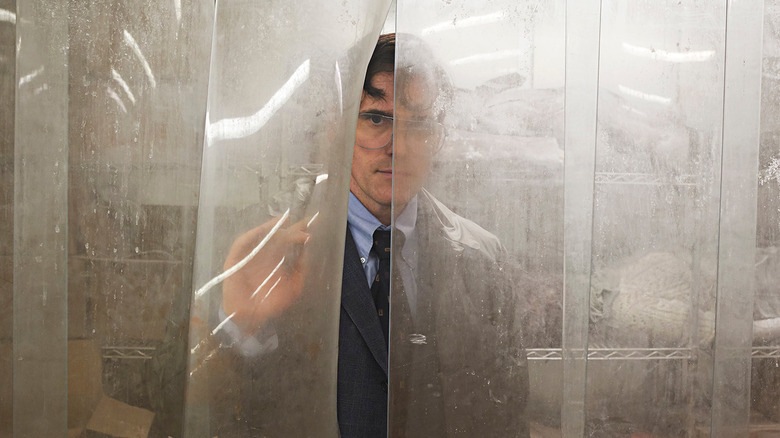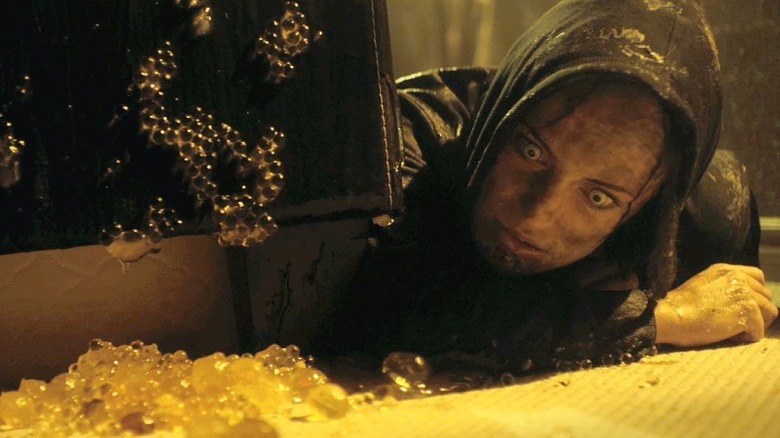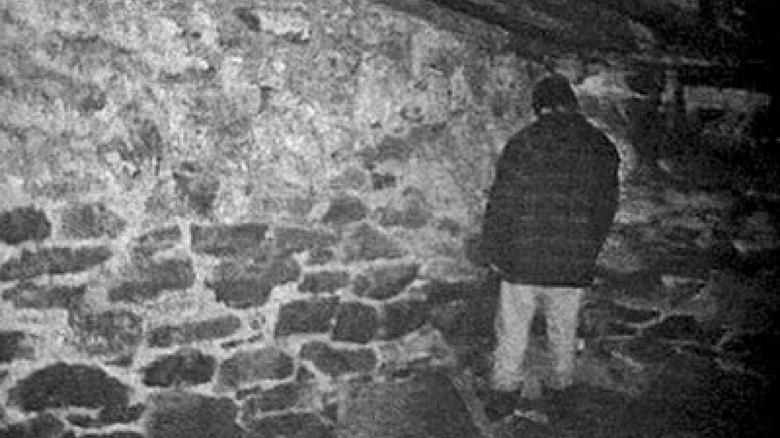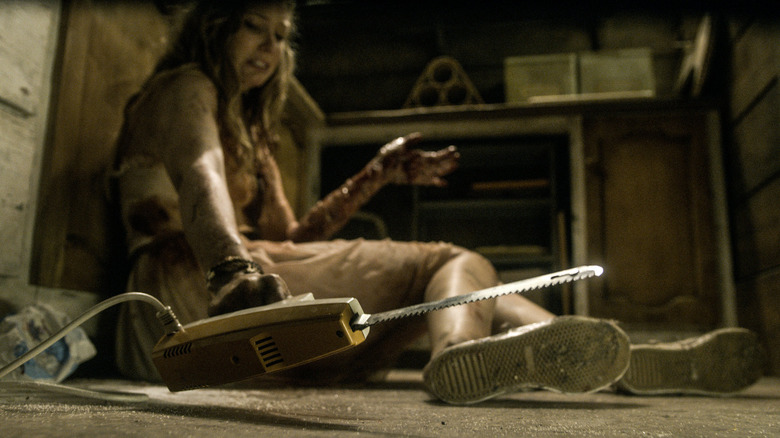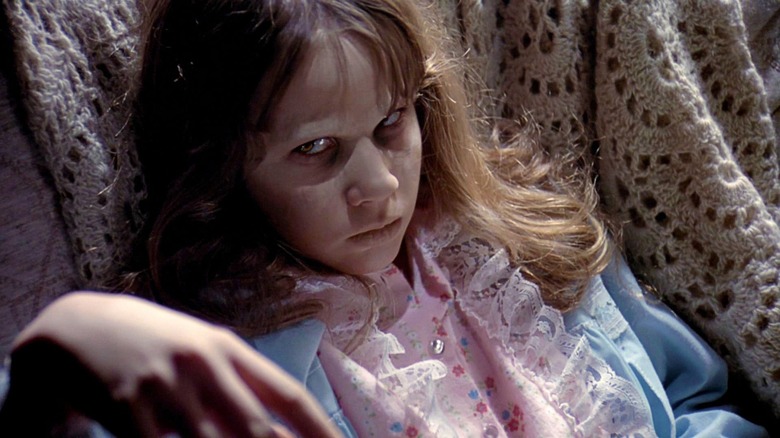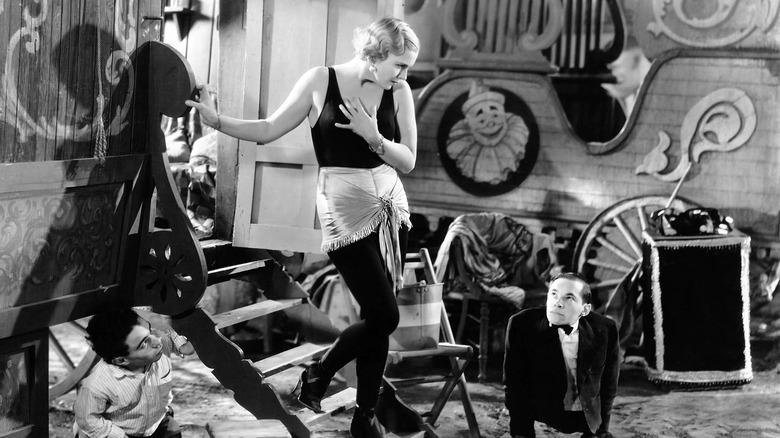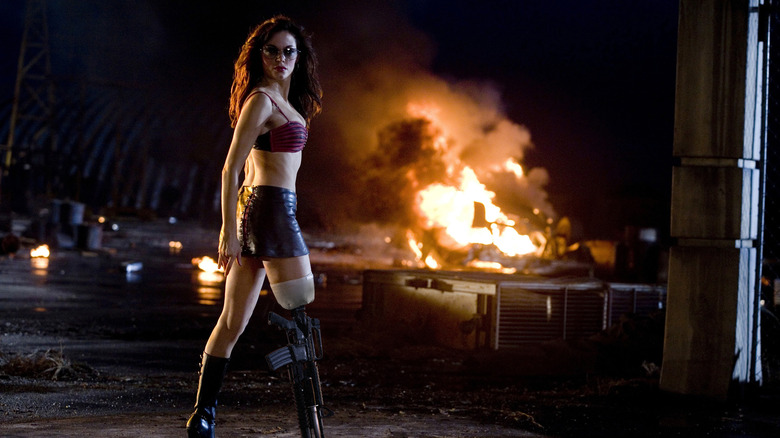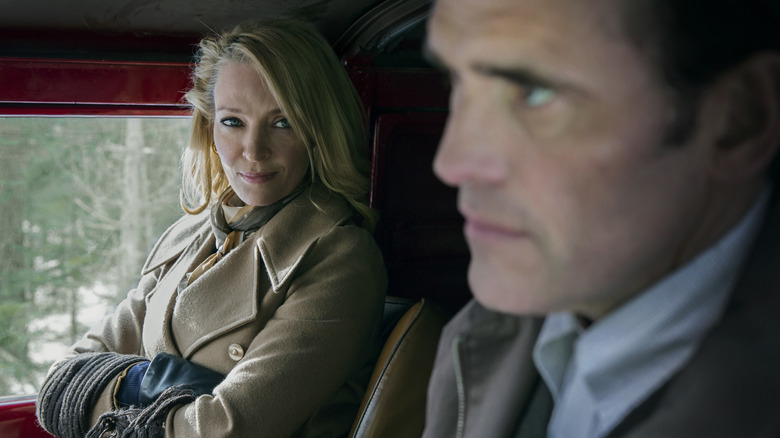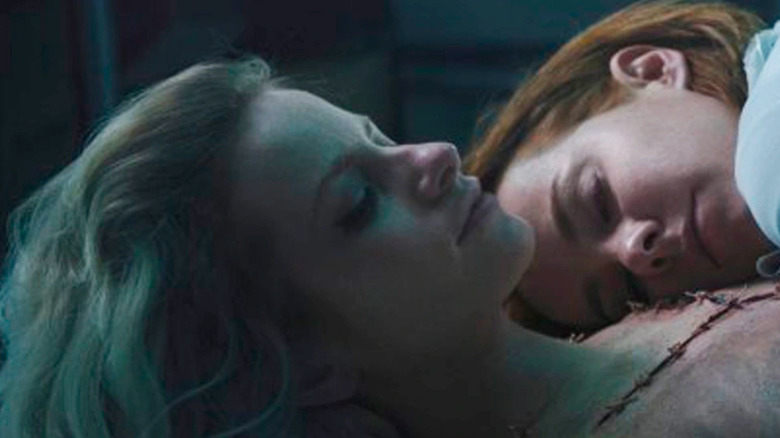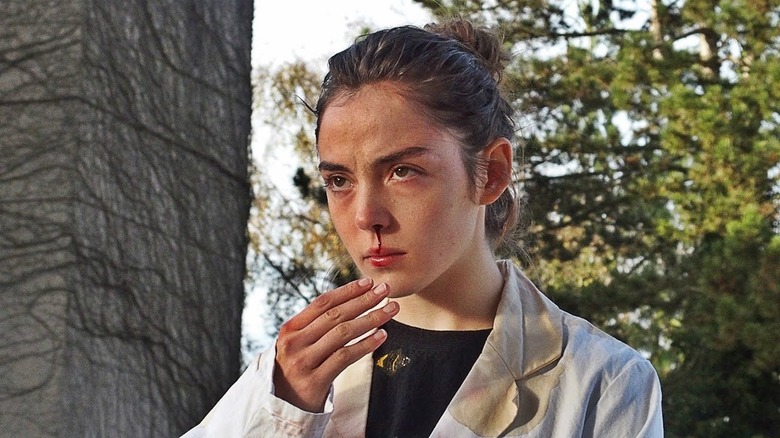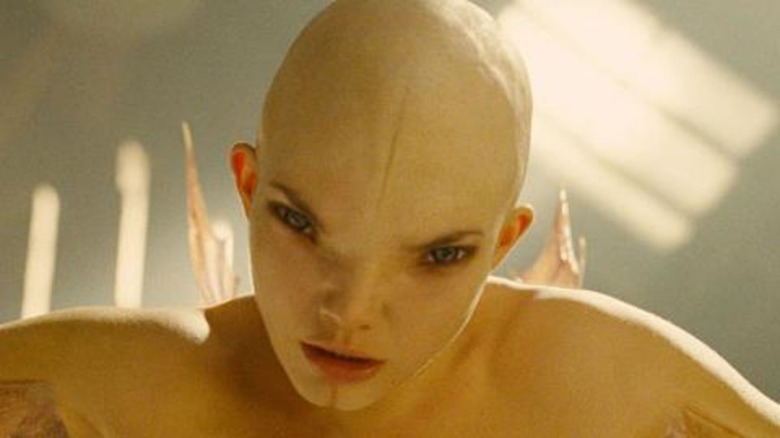Horror Movies Audiences Walked Out Of
There are many reasons for someone to walk out of a movie. In some cases, it's a sign that something has gone horribly wrong — the movie is boring, dull, and the walk back to the lobby sounds better than enduring another moment. In others, it's a sign that something has gone horribly right — a movie is so intense or upsetting that it's provoking the exact kind of visceral response a filmmaker was looking for. When the latter happens with a horror movie, you've struck some kind of twisted gold.
The /Film horror braintrust put their heads together and assembled this list of horror movies that sent audiences fleeing for the parking lot. Some of the reasons are painfully, hilariously mundane (they didn't know it was a double feature). Some are unexpected (motion sickness!). Some reflect a movie's harrowing, unsettling content. But all of them share this weird badge of (dis)honor. For one reason or another, a lot of people didn't, or couldn't, finish these 10 films.
Bite
Some speculate that reports of vomiting theater patrons during high-profile screenings are merely marketing stunts thanks to hired plants. Could a film cause reactions that require medical attention? At 2015's Fantasia Film International Festival, Chad Archibald's "Bite" fell under such scrutiny when two attendees supposedly fainted during the film's premiere. On his Facebook wall, Festival co-director Mitch Davis wrote, "2 people, fainted. One girl is puking and another hit his head on stairs. Truth." Producers anticipated a strong reaction to their wereinsect transformation flick because official "Bite" barf bags were handed to patrons upon entry to the theater — apparently, the odd swag was necessary. Luckily both patients found themselves in no further harm.
I remember hearing about the infamous "Bite" screening and wondering how any title could be as atrocious as "The Human Centipede 2 (Final Sequence)" or "Septic Man." I've eaten late-night dinners through the gnarliest movies — an occupational hazard when you're a horror critic. My constitution held strong during my at-home watch of "Bite," and I'll admit I was a bit underwhelmed given how nothing earned even the slightest sickness. Special effects try their damnedest when Casey (Elma Begovic) begins leaking goo and spewing egg sacks from her mouth as she morphs from bachelorette to killer buggy queen. It's more impressive than revolting, although juicy sound effects and squelchy noises might be enough to cause some gags from weaker audience stomachs. Then again, if the legend is true, there are indeed some who might flee this film for their safety. (Matt Donato)
The Blair Witch Project
"The Blair Witch Project" is known for many things: terrifying atmosphere, a horrifying sense of dread, and an incredibly effective viral marketing campaign. But the film made waves in another way during the halcyon days of its theatrical run. Some moviegoers were so physically affected by the film's camera work that many audience members were vomiting in the aisles and ended up walking out of the theater. People were allegedly asking for refunds. It's even been reported that ushers asked if audience members prone to motion sickness would sit in the aisle seats in some theaters in Toronto.
It makes sense that people with sensitivity to motion would have an issue with "The Blair Witch Project" that is wholly separate from the actual terror on screen. Part of what makes that movie so effective in both its scares and storytelling is the shaky camera work, since we're following a group of film students who, naturally, let their project go by the wayside when faced with a killer presence in the woods. It's realistic to a fault; It's uncomfortable to watch, but we endure it, and it tells us a lot about the stakes our leads face. The intensity is there in spades, which makes the theatrical response a justified reaction for folks who don't have the stomach for it. Not everyone can handle a shaky screen, especially not a large, movie theater-sized one, but that doesn't mean they didn't vibe with the story. After all, "The Blair Witch Project" is legendary for a reason. (Lex Briscuso)
Evil Dead
When it comes to contemporary remakes of legendary films, the critical consensus usually leans toward disgruntled eye-rolling. However, with the 2013 reboot of Sam Raimi's 1981 cult classic "The Evil Dead," the filmmakers managed to surpass the original on several impressive fronts: It ended up being gorier, grislier, and far more bleak. Though the film's plot remains essentially the same — five twenty-somethings stay in a remote cabin, which happens to hosts an ancient book in the cellar which will cause the group to become possessed and killed by a demonic entity — it boasts more explicit scares and feels solidly akin to the New French Extremity movement.
"Evil Dead" proved to be so disturbing that during the film's world premiere at SXSW, one of /Film's very own writers witnessed numerous audience members walking out of the theater, scurrying to the lobby out of nausea and disgust. Honestly, this kind of reaction is phenomenal for horror filmmakers, who aim to provoke incredibly visceral reactions from viewers. In fact, Bruce Campbell — who played Ash in "The Evil Dead" and co-produced the 2013 reboot — stated in an interview with Hollywood.com ahead of the film's release: "Hopefully we'll have a few walkouts. That's the sign of a good horror movie." As it turns out, Campbell's hope morphed into a tangible reality.
Who knows what could have irked people about the film so much. Surely it wasn't the copious amount of severed limbs, nor the black bile of indeterminate origin which is projectile vomited in order to signify a person's possession. Let's not even bring up the possibility of it being glass shards jaggedly cutting through the soft facial tissue of cheek and tongue — that's just horror for babies! In all seriousness, "Evil Dead" giddily revels in one-upping the original in every conceivable way, with escalated scares being a vital part of the remake's DNA. Not only was the film made for the die-hard fans of the original film, but also as a concerted effort to freak the freaks out. One of the better twenty-first century horror remakes, "Evil Dead" rests (un)easily among its arguably sub-par competition. (Natalia Keogan)
The Exorcist
The iconic 1973 horror film "The Exorcist" has been scaring the crap out of audiences for decades. There's no shortage of reports detailing shocked and frightened moviegoers walking out of screenings during its initial theatrical run, and there's even video evidence to back it up.
Like the people in the video, I totally get it. While I didn't yet exist in 1973, I recently watched "The Exorcist" for the first time and found myself completely shocked and a little traumatized. It's not that the movie is bad; in fact, it's a horror masterpiece that I can confidently say is one of the most disturbing movies I've ever seen in my life. It makes "Midsommar" look like a lighthearted, feel-good film. I mean, the scene featuring the film's 12 year-old possession victim defiling herself with a bloody crucifix, speaking in a detached voice while her head spins around unnaturally, is more than enough to freak out even the most hardened horror fans. Graphic depictions of children in peril are already a major taboo in film, and the fact that it also draws heavily upon real-life religious beliefs and rituals to harvest its many horrors only adds to the reason why many people were too scared (or offended) to see it through to the end.
Even though "The Exorcist" came out nearly 50 years ago, it's still easy to see why it was difficult to stomach for some. I found myself having to pause the movie several times to process what I was seeing — and to turn the lights in my room back on. The shock factor of the film is made even worse in retrospect with the knowledge that the actors and actresses experienced real violence and sustained serious injuries behind the scenes. (Deshawn Thomas)
Freaks
Tod Browning's 1932 horror film "Freaks" was one of the first films to truly shock audiences. "Freaks" tells the story of a troupe of circus performers, many of whom are physically disabled members of the sideshow. Browning was inspired to create the film after working with the traveling shows himself, and he wanted to give the performers a shot at the silver screen. Browning was trying to sympathize with the many performers, despite the fact that MGM executives found them disturbing. In the end, the studio mandated a scene where the sideshow performers all stab a beautiful (but evil) woman in a moment that's still terrifying to this day.
There are legends abound regarding "Freaks," including a test screening where a young woman claimed watching the film gave her a miscarriage. People were described as running from their seats, terrified by the images onscreen. "Freaks" came under heavy scrutiny and was even banned in the U.K., making it a "video nasty" before the term was even coined. What's frustrating about the reaction to "Freaks" is that Browning was trying to gain sympathy for the sideshow performers he had grown to know and love, and the studio and audiences treated them like monsters. "Freaks" is a fantastic film about found family, survival, and empathy, but audiences boiled it all down to basic fears of the Other. Audiences were less exposed to the realities of the world, and so the unusual nature of the "Freaks" seemed more shocking than it ever would today. After all, as Browning is trying to show us, they're just people. (Danielle Ryan)
Grindhouse
2007's "Grindhouse" was something of a gift for in-the-know cinephiles of the time. Quentin Tarantino and Robert Rodriguez each wrote and directed a feature film, with both entries set to play together in wide release as one cinematic experience. But when Rodriguez's "Planet Terror" and Tarantino's "Death Proof" hit theaters together under the "Grindhouse" title, it didn't all go according to plan — not by a long shot. Unfortunately, aside from a very specific subset of movie fans, general audiences either didn't care or didn't really understand what this was. That all led to a pretty disastrous result for two filmmakers with very solid track records.
The movie's well-documented box office failure can't be chalked up to the many, many walkouts, which were documented by those who did see the movie. Part of the problem was that so many people had zero idea what they were signing up for. Case in point, there were many instances of moviegoers watching people walk out after "Planet Terror" wrapped up, believing that they were just there to watch one move and only one movie. The notion that they paid to watch a double feature was lost on them entirely. Tarantino, after having time to reflect, addressed the failure of the ambitious project back in 2020 saying that he and Rodriguez felt that "people had a little more of a concept of the history of double features and exploitation movies." Rather, as he put it, "They had no idea what the f*** they were watching" and "it meant nothing to them."
The numerous tales of walkouts back up Tarantino's own thoughts on the matter. This is why international releases opted to split up the films and release them separately to avoid any further confusion and help to mitigate losses. (Ryan Scott)
The House That Jack Built
Director Lars von Trier has not developed a reputation for making what one might call easy, breezy cinema over the years. The filmmaker has a knack for crafting challenging, divisive movies. After all, this is the man who made the so-called "Depression trilogy," which consists of "Antichrist," "Melancholia," and "Nymphomaniac." 2018's "The House That Jack Built" is certainly no exception. The film, which sees Matt Dillon playing a particularly sadistic serial killer whose awful deeds play out in graphic detail on screen, was so repugnant in the eyes of many moviegoers that they didn't just walk out, but walked out in utter, vocalized disgust. Many of the character's victims are women and the murders play out in no-holds-barred fashion. It is grim and that type of cinema is not for everyone, to say the very least.
This all dates back to the movie's now-infamous screening at the Cannes film festival in 2018. As was reported at the time by those who were in attendance, the screening prompted more than 100 walk-outs, which is not all that common at a major film festival such as this. A woman apparently muttered "it's disgusting" as she made her way for the lobby. The news spread pretty quickly at the time and helped build some pre-release buzz for the film, as controversy can have that effect. And this wasn't even the only controversy "The House That Jack Built" would ultimately face, as distributor IFC Films got in trouble with the MPAA over the movie's one-night-only release of the unrated cut, which happened very close to its larger R-rated rollout. (Ryan Scott)
The Neon Demon
"Drive" helped bring Nicolas Winding Refn into the mainstream, and, like Nirvana releasing "In Utero" after the chart-topping glory of "Nevermind," the filmmaker immediately followed his success up with creations designed to alienate his new fans. There was the extremely slow-burning "Only God Forgives," and then there was the deliciously trashy "The Neon Demon." Ostensibly the tale of a young model (Elle Fanning) trying to make it in Hollywood, "The Neon Demon" starts off normal enough before getting weirder with every turn, introducing cannibalism, shape-shifting, and Keanu Reeves playing a real creep. In her quest for stardom, Fanning's character befriends a mysterious make-up artist played to strange perfection by Jena Malone. When she's not applying foundation to starlets, Malone's character also moonlights as a beautician for the dead at a funeral home. And midway through the film, Refn decides to lay all his cards on the table and give us a scene where Malone's character has sex with a corpse.
When I saw "The Neon Demon," I could feel the vibe in the theater slowly shifting. People were growing uncomfortable and antsy with all the trashy weirdness up on the screen. And then came the necrophilia scene. Refn lets it unfold slowly as Malone's character delicately moves in for some post-death eroticism, and it was the last straw for much of the audience. There was a cacophony of sounds within that darkened room as one by one, people bolted up from their seats and fled, disgusted. I don't have an exact count, but it genuinely felt like at least half the audience hightailed it out of there. I stayed put, grinning like an idiot, amused at how Refn was essentially poking the audience with a stick while screaming "LOOK HOW PROVOCATIVE I AM!" (Chris Evangelista)
Raw
The best recipes, the ones that hit home and stay with you, are simple. The fewer ingredients the better, whether you're whipping up a meal or shaking up a cocktail. And if you were looking for a recipe to make a fully grown adult faint, you'd only need one ingredient: Julia Ducournau's 2016 cannibal-goes-to-college horror film "Raw." The French film hit audiences hard when it was screened at the Toronto International Film Festival, leading to an ambulance getting called for at least one movie-goer. Despite the shocking news, the marketing team behind "Raw" definitely knew how to pivot. They included branded barf bags as swag for at least one critic's screening of the film.
And you do have to give it to Ducournau — the movie is filled with bloody moments that could easily curdle a stomach filled to the brim with soda and popcorn, but any seasoned horror fan would probably be more interested in how she pulled off the gore instead of puking into their lap. Ducournau's splashes of blood operate like precise drips of paint, covering the students of the veterinary school where the movie takes place (a la "Carrie") and popping up in more extreme slashes, like when a corpse gets eaten. You know, casual stuff. Regardless of where you fall on the "Raw" scale, from "I can eat a steak while watching" to "I have to keep my barf bag handy," the gore in Ducournau's first feature film has taken on a life of its own. Cannibal movies have their own transgressive allure, from "The Silence of the Lambs" to "Cannibal Holocaust," and "Raw" slots in nicely. It's the perfect arthouse dare, gross enough to shock your normie friends, but purposeful enough that they'll still watch it. (Kaylee Dugan)
Splice
If you were to take the premise of "Frankenstein" and season it with the incestuous elements of "Oedipus," you'd get Vincenzo Natali's 2010 sci-fi horror movie "Splice." In the film, Adrien Brody and Sarah Polley play two unethical scientists named Clive and Elsa. Not only do they make a terrible couple, but they also make a terrible little mutant child named Dren using a variety of animal genes in addition to Sarah's own DNA. Now they're a family!
Unsurprisingly, Dren turns out to be an unstable abomination and cat murderer, but it isn't until Adrien Brody's character decides to engage in pseudo-incestuous intercourse with a rapidly maturing Dren that it became offensively terrible. I vividly recall my screening, and the number of people who started walking out during this scene, with one guy angrily shouting "OH, SO HE'S F****** IT?" before stomping out of the theater. I should have left with him, but my date wanted to stay, arguing that it couldn't possibly get any worse. And then it got worse. Dren becomes violent, changes sex, and then sexually assaults and impregnates Elsa. At that point, even more people left.
The film ends with a visibly pregnant Elsa accepting an offer to sell the offspring of her mutant murder child to science. Despite the fact that "Splice" somehow managed to get a pretty decent critical response, there's no shortage of reviews describing the same disgust, theater walkouts, and overall disdain that I experienced when I first laid eyes on what was essentially "Jurassic Park" for perverts. (Deshawn Thomas)
